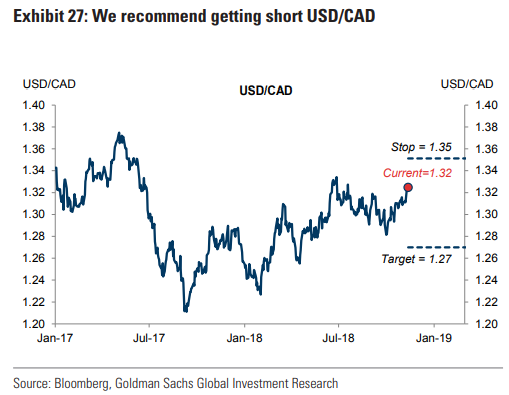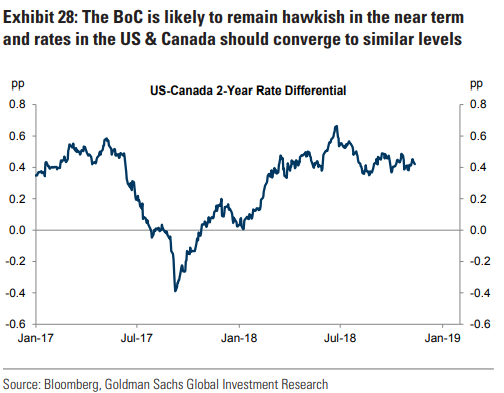The Canadian Dollar is a Buy say Goldman Sachs and Julius Baer
- Written by: James Skinner
-

Goldman Sachs headquarters, New York. © Ludovic Bertron
- USD/CAD rate is a sell say Goldman Sachs and Julius Baer.
- Interest rate differential to stabilise, offering support to CAD.
- USMCA to pass lawmakers' test, but oil price to be a headwind.
The Canadian Dollar is likely to rise steadily against its U.S. rival over the coming quarters, according to analysts at Goldman Sachs and Julius Baer, who say buying the Loonie is one of their best investment ideas.
Goldman Sachs says the Bank of Canada (BoC) will continue to raise interest rates in the year ahead, and that it might move at a faster pace than the U.S. Federal Reserve (Fed).
This will prevent the gap between policy rates on either side of the border from growing any wider, which is expected to generate some support for the Canadian Dollar as the year goes on.
"We recommend getting short USD/CAD with a target of 1.27, or spot return of 4%. The US and Canada are at similar stages of the economic cycle, meaning the BoC is likely to remain hawkish in the near term and rates should converge to similar levels," says Kamakshya Trivedi, global co-head of foreign exchange research at Goldman, in a briefing to clients.

Above: Goldman Sachs graph showing risk-return profile of trade.
The U.S. Federal Reserve had been raising its interest rate already for almost two years before the Bank of Canada began to normalise its own monetary policy settings.
This left the BoC and its interest rate trailing behind their U.S. rivals but a commodity price recovery and robust levels of economic growth have enabled Canadian policymakers to attempt a catch-up.
Septembers United-States-Mexico-Canada Agreement (USMCA) has given the BoC a green light to raise rates even further because it saved the NAFTA trade deal from termination in the hands of President Donald Trump.
That neutered what was a major threat to the economy and currency because other analysts had warned that a termination would lead to slower growth and lower interest rates over the longer term, to such an extent it could have reduced the Loonie's value by up to 20%.
"Even though uncertainty lingers around the passage of USMCA, it should be less of a headwind to CAD than it had been prior to the deal announcement (due to lower tail risk), and our DC economists expect the agreement will eventually be approved," says Trivedi.

Above: Projected US-Canada interest rate differential.
The Goldman team forecast that, with uncertainty over trade fading and now most oil prices have stabilised following the two-year collapse that ended in 2016, the BoC will raise its interest rate four times next year.
That will take the Canadian interest rate up to 2.75%. U.S. rates are expected to continue rising as well, although the Federal Funds rate is seen ending 2019 around 3.25%. This will keep the rate differential stable at 0.5%.
"The economic outlook for Canada continues to look robust. Headline inflation is above target and drivers for further inflation pressure remain in place. We therefore believe that the Bank of Canada will continue to normalise interest rates also in the coming year," says David Meier, an economist at Swiss private bank Julius Baer.
The Bank of Canada raised its interest rate by 25 basis points to 1.75% in October and said it will go on lifting its benchmark rate over coming quarters, potentially taking the cash rate up to 3.5%.
The market-implied Canadian cash rate for Wednesday 09, January is 1.97%, suggesting investors are confidently anticipating another rate rise in January.
An additional full rate hike is priced in by July, although derivatives markets do not even come close to pricing four full interest rate rises for the 2019 year. When investors do begin flirting with this idea, the Loonie will receive a boost.
"Rising interest rates and diminishing uncertainty from US trade politics open the door for the loonie to appreciate alongside the strong US dollar. This in particular against European peers, such as the euro or the Swiss franc, where rate normalisation is still in the distant future. We therefore recommend going long the CAD versus the CHF and EUR," Meier adds.
However, and despite the more supportive montetary policy outlook, anticipated events in oil markets are likely to be a headwind to the Canadian Dollar during the months and quarters ahead.
West Texas Intermediate and Brent crude prices rose by more than 15% each during the 11 months to the beginning of November. And although both benchmarks have since handed back all of their gains, the Loonie has appeared oblivious to higher prices through much of the year despite Canada's largest export being oil.
This is because prices of the Canadian benchmark have diverged from those of its global peers thanks to a range production challenges and domestic policy issues. And the difference between prices of Western Canada Select and its WTI rival is expected to remain large throughout the coming year, depriving the Loonie of support from the oil market.
"Our equity analysts also see scope for some improvement from current WCS spot levels," says Goldman's Trivedi. "However, they expect the WTI-WCS spread to average $30 in 2019 (wider than consensus) as capacity constraints likely remain prominent, which could limit CAD outperformance in the medium term."
Nonetheless, the Goldman team says the USD/CAD rate should decline by around 4% to 1.27 over the coming months. They've advised clients to sell the exchange rate "short", targetting 1.27, with a stop-loss at 1.35.
The USD/CAD rate was quoted 0.17% higher at 1.3165 Monday and is up 4.6% for the 2018 year-to-date. The Pound-to-Canadian-Dollar rate was 0.45% higher at 1.6932 but has declined -0.04% this year.
Advertisement
Bank-beating exchange rates. Get up to 5% more foreign exchange by using a specialist provider to get closer to the real market rate and avoid the gaping spreads charged by your bank when providing currency. Learn more here





